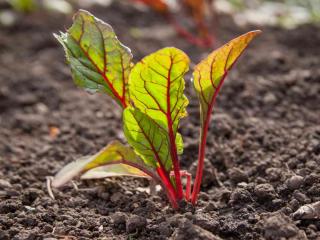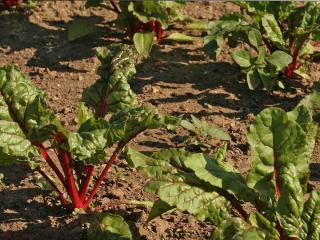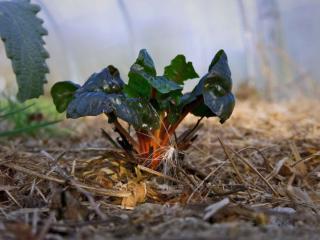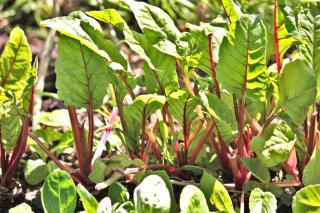

Silverbeet or chard is a leaf green also grown for its stalks.
Summary of silverbeet facts
Name – Beta vulgaris
Family – Chenopodiaceae
Type – biennial, vegetable
Height – 12 to 20 inches (30 to 50 cm)
Exposure – full sun, part sun
Soil: rather rich and acidic – Sowing: spring – Harvest: summer-fall
This biennial is much appreciated for all its parts, leaf and stalk.
Silverbeet is a vegetable that can be sown in spring or planted to the ground a bit later if you’ve purchased it in nursery pots.
If you would rather try to sow, either sow in April or May in a nursery for cold-weathered climates or direct sowing for warmer regions.
 Take care that it doesn’t freeze anymore, or protect them with a plastic tunnel greenhouse if there is any risk.
Take care that it doesn’t freeze anymore, or protect them with a plastic tunnel greenhouse if there is any risk. If purchased in nursery pots, silverbeet can be planted all spring long, spacing them 12 to 16 inches (30 to 40 cm) apart on all sides.
If purchased in nursery pots, silverbeet can be planted all spring long, spacing them 12 to 16 inches (30 to 40 cm) apart on all sides.
 Growing silverbeet is possible in pots. It helps to have rich soil and excellent drainage.
Growing silverbeet is possible in pots. It helps to have rich soil and excellent drainage.
It’s very important to water regularly, even more so than in the ground. Indeed, potted soil tends to dry out much faster.
Water morning and evening, without wetting leaves.
 Usually the harvest season for silverbeet extends from July up to the first frost spells, depending on the time of sowing, planting, and on your needs.
Usually the harvest season for silverbeet extends from July up to the first frost spells, depending on the time of sowing, planting, and on your needs.
There are 2 main phases regarding winter care for silverbeet, one phase is before it freezes and the other once the freezing season is over and the plants enter their vegetation phase.
 Best is to protect your silverbeet from the cold.
Best is to protect your silverbeet from the cold. Silverbeet belongs to the same family as red beet, and is much appreciated for its leaves and stalks which are very interesting from a culinary point of view.
Silverbeet belongs to the same family as red beet, and is much appreciated for its leaves and stalks which are very interesting from a culinary point of view.
It is eaten both cooked or raw, just like spinach, but it is generally found to be sweeter.
In the south of France, around Nice, silverbeet is an omnipresent vegetable. It is cooked there in omelets, baked with cheese, added to pies and even desserts!
Silverbeet is without doubt a true heirloom vegetable that deserves to be invited to our mealtimes more regularly!
 Many health benefits of silverbeet are often unknown to the public at large.
Many health benefits of silverbeet are often unknown to the public at large.
Low in calorie intake and rich in fibers, it is a great source of vitamins C and A, iron and magnesium, which makes it an excellent vegetable for fighting drowsiness.
It eases transit and has diuretic and laxative effects on our body.
Silverbeet likes the soil to stay moist, especially when the weather is hot. Remember to mulch in summer to keep the soil cool.